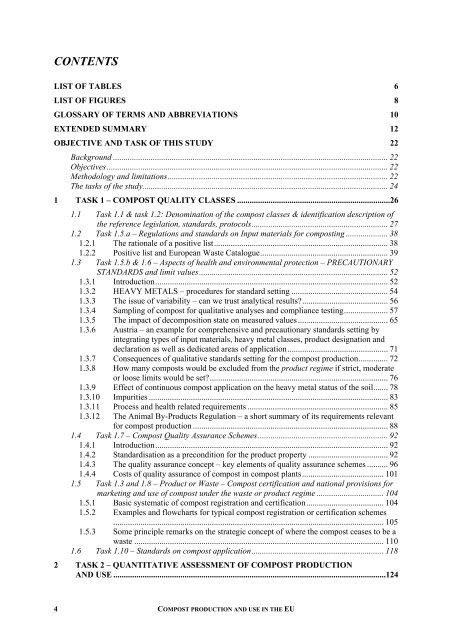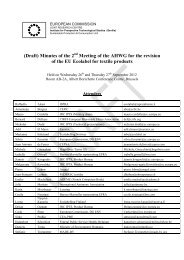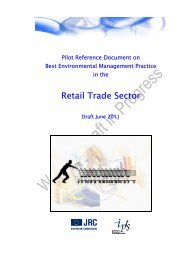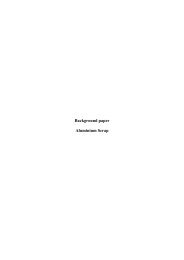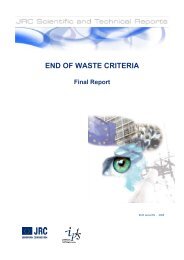final report - JRC IPTS - Sustainable Production and Consumption ...
final report - JRC IPTS - Sustainable Production and Consumption ...
final report - JRC IPTS - Sustainable Production and Consumption ...
Create successful ePaper yourself
Turn your PDF publications into a flip-book with our unique Google optimized e-Paper software.
CONTENTS<br />
LIST OF TABLES 6<br />
LIST OF FIGURES 8<br />
GLOSSARY OF TERMS AND ABBREVIATIONS 10<br />
EXTENDED SUMMARY 12<br />
OBJECTIVE AND TASK OF THIS STUDY 22<br />
4<br />
Background ................................................................................................................................... 22<br />
Objectives ...................................................................................................................................... 22<br />
Methodology <strong>and</strong> limitations......................................................................................................... 22<br />
The tasks of the study..................................................................................................................... 24<br />
1 TASK 1 – COMPOST QUALITY CLASSES .........................................................................26<br />
1.1 Task 1.1 & task 1.2: Denomination of the compost classes & identification description of<br />
the reference legislation, st<strong>and</strong>ards, protocols................................................................. 27<br />
1.2 Task 1.5.a – Regulations <strong>and</strong> st<strong>and</strong>ards on Input materials for composting .................... 38<br />
1.2.1 The rationale of a positive list................................................................................... 38<br />
1.2.2 Positive list <strong>and</strong> European Waste Catalogue............................................................. 39<br />
1.3 Task 1.5.b & 1.6 – Aspects of health <strong>and</strong> environmental protection – PRECAUTIONARY<br />
STANDARDS <strong>and</strong> limit values.......................................................................................... 52<br />
1.3.1 Introduction............................................................................................................... 52<br />
1.3.2 HEAVY METALS – procedures for st<strong>and</strong>ard setting .............................................. 54<br />
1.3.3 The issue of variability – can we trust analytical results?......................................... 56<br />
1.3.4 Sampling of compost for qualitative analyses <strong>and</strong> compliance testing..................... 57<br />
1.3.5 The impact of decomposition state on measured values........................................... 65<br />
1.3.6 Austria – an example for comprehensive <strong>and</strong> precautionary st<strong>and</strong>ards setting by<br />
integrating types of input materials, heavy metal classes, product designation <strong>and</strong><br />
declaration as well as dedicated areas of application................................................ 71<br />
1.3.7 Consequences of qualitative st<strong>and</strong>ards setting for the compost production.............. 72<br />
1.3.8 How many composts would be excluded from the product regime if strict, moderate<br />
or loose limits would be set?..................................................................................... 76<br />
1.3.9 Effect of continuous compost application on the heavy metal status of the soil....... 78<br />
1.3.10 Impurities .................................................................................................................. 83<br />
1.3.11 Process <strong>and</strong> health related requirements ................................................................... 85<br />
1.3.12 The Animal By-Products Regulation – a short summary of its requirements relevant<br />
for compost production ............................................................................................. 88<br />
1.4 Task 1.7 – Compost Quality Assurance Schemes.............................................................. 92<br />
1.4.1 Introduction............................................................................................................... 92<br />
1.4.2 St<strong>and</strong>ardisation as a precondition for the product property ...................................... 92<br />
1.4.3 The quality assurance concept – key elements of quality assurance schemes .......... 96<br />
1.4.4 Costs of quality assurance of compost in compost plants....................................... 101<br />
1.5 Task 1.3 <strong>and</strong> 1.8 – Product or Waste – Compost certification <strong>and</strong> national provisions for<br />
marketing <strong>and</strong> use of compost under the waste or product regime ................................ 104<br />
1.5.1 Basic systematic of compost registration <strong>and</strong> certification..................................... 104<br />
1.5.2 Examples <strong>and</strong> flowcharts for typical compost registration or certification schemes<br />
................................................................................................................................. 105<br />
1.5.3 Some principle remarks on the strategic concept of where the compost ceases to be a<br />
waste ....................................................................................................................... 110<br />
1.6 Task 1.10 – St<strong>and</strong>ards on compost application............................................................... 118<br />
2 TASK 2 – QUANTITATIVE ASSESSMENT OF COMPOST PRODUCTION<br />
AND USE ..................................................................................................................................124<br />
COMPOST PRODUCTION AND USE IN THE EU


